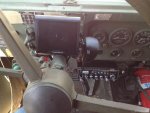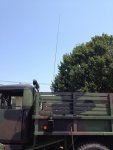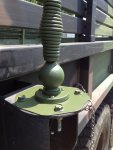Please do not have CB radios peaked and tuned. What this does is remove the modulation controls and crank the power up beyond the radio's ability to produce a clean and distortion-free signal.

This causes interference to other channels. When you are listening on 18 and some idiot with a peaked and tuned radio is on 19, you will hear the garbage from his modulator splattering on 18, and it is often not just one channel away that it splatters, but many. So you are trying to talk to your brother 5 miles away, and you can't hear him because of the trash splattering for 6 channels in either direction from some nincompoop with a radio that was worked on by another nincompoop.
It is just as illegal to use an amplifier, but that is a better solution (if done right) that making the radio sound nasty and splatter like a piece of junk. It is a diminishing return though.
"If done right" does not mean taking the amp out of the box and hooking it to a stock CB. The input of the amp in many cases requires only 2-3 watts to get near maximum output (don't believe it? look up the datasheets on the RF amplifier transistors the amp uses, they are online). A radio makes 12 watts peak power and will overdrive the amp and it will splatter all over the band. This also slowly destroys the transistors in the amp. The amp needs modified to attenuate the signal from the radio so that the key-down power actually getting to the amp's input (inside the box) is no more than what is required to make the amp produce 1/4 of its peak output power rating. An engineer who works in a legit RF employ will build an attenuator for that purpose. A good tech might know how to design that.
These things can't be done properly by the wizard at the truck stop. Said wizard will insist that he can do them and has done hundreds of them, even though he has not have the calibrated test equipment necessary in 90% of the cases, which includes an oscilloscope as a minimum and also various signal generators and meters.
The screwdriver jockey's CB power meter is also likely some cheaply made junk brand, not a professional or ham or military one. (even if he paid $200 for that big 5KW DOSY meter, if it is not the proper design then it does not matter) Many/most CB radio shop power meters will show your radio now has 25-30 watts 'swing'. In reality, no it does not. Those meters are purposely designed for this bootleg peak/tune/linear-amp industry.
Sadly, truck drivers don't really know anything about this either and that is why they get the peak and tune, and their radios splatter. Too bad they listened to the CB salesman for that '$20 peak and tune special' and let the screwdriver jockey get his claws on the set.
meters: If you put inline a CB wattmeter (Dosy, workman), a ham wattmeter (Daiwa, other 'ham' brand), a commercial wattmeter (Bird), a military wattmeter, and a dummy load, and then key the transmitter, guess which three meters will agree? Guess which three will not fly upscale to ridiculous false power indications when the mike is whistled into?
Here's a nice article about the errors of CB wattmeters, techs, salespeople, and linears:
Research: Tube Type "CB" Linear Amplifiers
It also applies 100% to modern transistorized/FET ones.
CB radios are designed to be as effective as possible as-designed, within the constraints imposed by the regulations for the service. If the radio cost more than about $100 up to $200, you can be sure it will do as good, loud, and clean a job as technically possible, bone stock.
Please keep the CB radio stock and do not use an amplifier unless you really know exactly what you are doing. (and are willing to break the law too which likely falls on deaf ears). OK add a power mike, but don't have some wizard open the radio and mess with it.
Distance: Multiplying the power x10 only gets twice the range. x100 four times the range. An experiment I know of firsthand showed that the maximum CB range (non-skip) was about 40 miles with a 1100 watt amplifier. That is a big amp consuming up to 150 amps from the car battery. The signal quality was just like from the stock CB at 8-10 miles. Not too great. It is the same for any radio service using the same modulation method -ham radio, etc. the distance is a root of the power relationship and there are formulas for that. It's science.
Don't be fooled by cheap workmen. Engineers know what they are doing and would not fix CB for the meager living. A really qualified technician would not waste his life working at a CB shop unless he has no need of the real $$ that other work would bring. Screwdriver jockeys do not know enough, but that is why they do that work and there are bazillions of them. They go in and cut a wire on a diode to destroy the modulation limiter and crank up the power while whistling into the mike till that cheap lying meter goes up-scale. Radio is then ruined. I'd never waste my time fixing CB for a primary living. ugh. $10/hr plus commission maybe. a way to be poor. I guess this might tick off some folks but I've seen it and worked with those guys therefore the advice to at least find one that knows what he is doing.
There are exceptions to the screwdriver jockey - the technician or engineer who is retired and wants a little hobby for some extra $. Find that guy and use him if the radio is broken but please do not turn the set into a piece of distorting junk.

I can rant on this "CB peak and tune" stuff because I owned an electronics repair business for 11 years and worked with a local CB shops and car stereo shops - -they sent me the car radios and I sent them the CBs. During that time I saw several techs come and go at each place. the good, bad, ugly.
I have also built and repaired receivers, transmitters, and RF amplifiers of all types fro 10 to 6000 watts, some from my own designs and others from older tube type units to military equipment and relatively high end commercial rigs like Harris gear and I also own an AM broadcast transmitter.
I guess I am spoiled on pleasant-sounding and easily understood sound of good-quality communications audio. Which the CB radio can be, if the set is left alone and not defiled.



 on
on 



